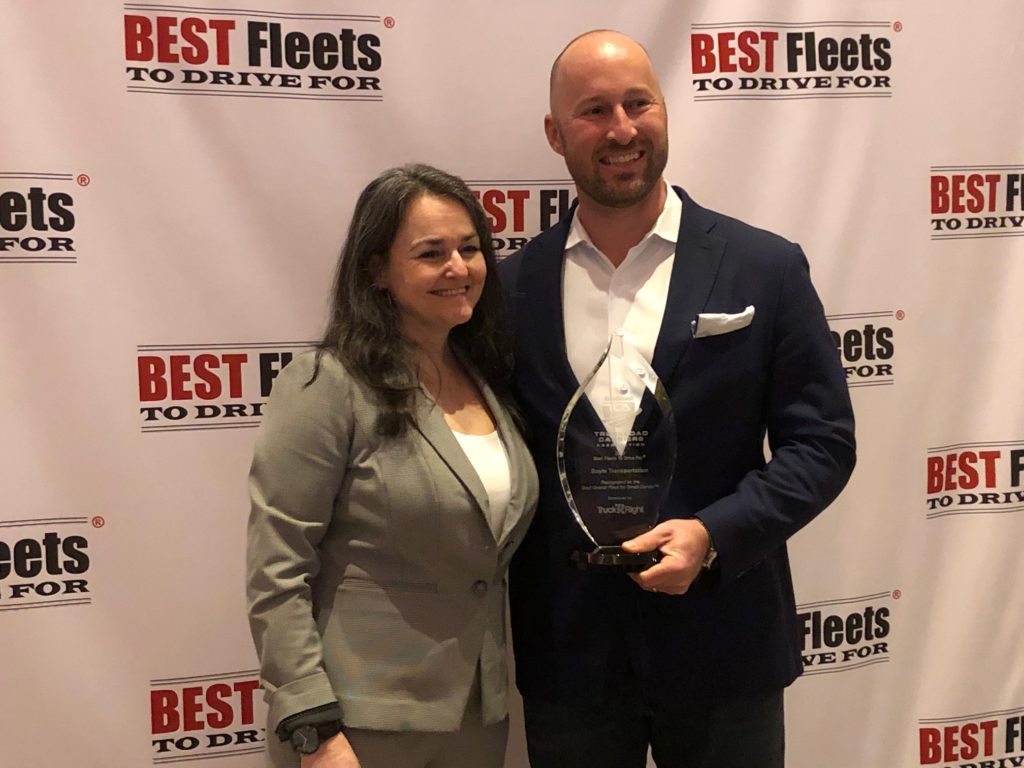Behind the Scenes of the Best Fleets to Drive For – Part 5
From a pool of 115 nominees, Boyle Transportation and Nussbaum Transportation were revealed as the overall winners of the Truckload Carriers Association’s 2020 Best Fleets to Drive For contest, in the respective small and large categories.
Nussbaum became the first fleet to win the grand prize in both small and large fleet categories. It was the top overall small fleet last year.
The operation with 442 drivers was recognized for its approach to new technology adoption, where a focus on personal needs ensures that enhancements optimize – rather than disrupt – driver efficiency. The company’s creative approach to HR and professional development programs also earned top scores across a variety of categories, according to program judges.
Boyle Transportation, with 133 drivers, stood out for its investments in driver support programs and operational efficiency improvements. Its guaranteed pay, provision of cell phones and connectivity tools, and a generous scholarship all demonstrated a willingness to invest in areas many fleets are reluctant to explore, administrators said.

Andrew Boyle, co-president of Boyle Transportation, told Today’s Trucking the program provides a valuable third-party validation of its workplace strategies.
“It’s very comprehensive, rigorous, and metric-based, so it’s not overly subjective,” he said of Best Fleets, adding the company gathers each spring to evaluate its performance versus its peers. “We take a lot from it. There’s a lot of peer learning, and it’s a good kind of peer pressure.”
CarriersEdge chief executive officer Jane Jazrawy noted that both Boyle and Nussbaum are seeing impressive results from their programs. Both have driver satisfaction scores above 93% and driver turnover under 20%. Mark Murrell, co-founder of CarriersEdge said both overall winners “have a continued focus on creative programs that are different from what other people are doing, and they’re doing new things every year. Both have been in the Top 20 and they keep going, they’re never satisfied just being on the list. In both cases they have things they’ve been doing for a while that other people still aren’t doing.”
After the awards had been doled out and the winners celebrated, the final chapter in the 2020 Best Fleets story was still to come. Jazrawy and Murrell hosted a breakout session at the TCA convention, during which they revealed trends and highlights from carriers participating in this year’s program.
Income flat, but miles down
Judges were surprised to see income remained flat in 2019, after widespread pay increases in 2018. However, upon closer look, drivers saw an impressive increase in their pay rate from 53.29 cents per mile in the 2019 competition results to 61.77 cents per mile in 2020. Mileage, however, was down from 122,244 in 2019 to 108,777 this year, suggesting drivers took advantage of pay increases to run fewer miles while maintaining their income.
For owner-operators, the trend was even more pronounced, with annual income dipping from $194,024 to $183,458, but on significantly fewer miles – bringing their pay to $2.17 a mile from $1.72 the year before.
Murrell also noted a lot of the extra pay that drivers earned was associated with things like detention time and loading compensation. Driver surveys suggest more can be done. The lowest-rated question on the survey asked drivers if they feel they’re fairly compensated for the extra work they’re required to do, such as wait time, training and driver meetings.
“Food is not compensation,” one driver quipped.
“You guys give out swag all the time. You may as well give it to people before they even start. Don’t wait for Driver Appreciation Week.”
Pre-orientation welcomes, loot bags
Pre-orientation welcomes have surfaced as a trend among the best fleets, according to Jazrawy. These can range from loot bags to calls from operations managers before drivers arrive at orientation.
“You guys give out swag all the time. You may as well give it to people before they even start,” Jazrawy reasoned. “Don’t wait for Driver Appreciation Week.”
Best fleets take advantage of orientation to exchange expectations with new hires, too.
“What does the driver expect and what does the company expect? Expectations are going up,” she said. “It’s really good to have it written down and signed off.”
Some leading fleets invite spouses to be a part of orientation, so they know what to expect. Face time with upper management during orientation is another trend appreciated by drivers. Jazrawy said some fleets offer gift cards to new hires so they can personalize their truck. More fleets are offering drivers additional time with their truck in orientation, so they’re more comfortable with it when they head out on the road. If you have a mobile app drivers are expected to use, give it to them before orientation so they’re already familiar with it, Jazrawy advised.
She also said mentorship programs are great – as long as you’re careful to choose appropriate mentors. Some drivers complained of mentors who were disinterested or unavailable.
Measuring real retention
Measuring driver retention for the purposes of Best Fleets isn’t easy. Murrell recalled that, in a previous year, a fleet was punished for high turnover, but many of its drivers had returned after pursuing greener pastures.

So now, the formula used by program judges factors in everything from retirements to medical issues, downsizing, terminations, and drivers who leave and then return. Canadian fleets scored 37.86% better than their U.S. counterparts, which Murrell could only attribute to cultural differences.
The Top 20 Best Fleets to Drive For had real turnover rates of just 22.3%, much better than the industry average, while all finalists averaged turnover of 32%.
Focus on safety
Driver safety is an increasing concern among professional drivers, particularly women. Some Best Fleets have installed panic buttons in truck cabs, while others offer to cover the cost of parking if a safe, free alternative isn’t available. Jazrawy said carriers that do more to make drivers feel safe while on the road have a higher percentage of female drivers.
What does a driver’s week look like?
This year’s Best Fleets program took a deeper look into what a driver’s week looks like, how long they’re on the road, and how much home time they get. The questionnaire for the first time asked how long drivers are home between trips, and found 62.3% of drivers are home between 34 and 48 hours, but only 13% are home for more than 48 hours.
“Most of you have a weekend that is longer than 34 hours,” Murrell told those in the room. “There’s a disconnect between what is considered a weekend for drivers and what is considered a weekend for everybody else in the office.”
Administrators also asked fleets what they’re doing to minimize equipment-related downtime, and found more fleets are scheduling maintenance at night or around the driver’s schedule. Best Fleets are also doing a better job at holding shippers accountable for tying up drivers, and are offering detention pay sooner, in some cases as soon as the driver arrives on-site.
“The two-hour people are the outliers on the slow side now,” Murrell said.
Staying connected
Finally, program judges this year looked at how drivers stay connected with family and the company itself. Murrell said social media has become ubiquitous among finalists. Many fleets are putting a lot of effort into helping drivers share best practices. An emerging trend is podcasting, through which senior management provides frequent communication to drivers.
“Five years ago, nobody was talking about podcasting,” Murrell said. “It’s a great opportunity for drivers to share ideas and collaborate with each other and I expect to see a lot more.”
—
Today’s Trucking editor James Menzies was embedded
in this year’s Best Fleets to Drive For judging process.
This is the final installment in the series.
Have your say
This is a moderated forum. Comments will no longer be published unless they are accompanied by a first and last name and a verifiable email address. (Today's Trucking will not publish or share the email address.) Profane language and content deemed to be libelous, racist, or threatening in nature will not be published under any circumstances.